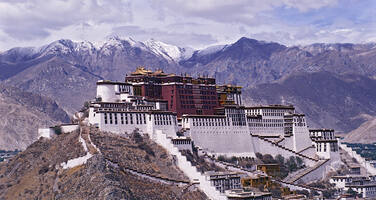Historic Ensemble of the Potala Palace, Lhasa
Factors affecting the property in 1998*
- Deliberate destruction of heritage
- Housing
- Major visitor accommodation and associated infrastructure
- Management activities
- Management systems/ management plan
- Relative humidity
- Ritual / spiritual / religious and associative uses
Factors* affecting the property identified in previous reports
- Boundaries of the property
- Pressures of urban development and Growth in tourism-related activities resulting in many construction activities
- Reconstruction and/or demolition of historic structures and rebuilding with new material and design features
- Deterioration of mural paintings due to humidity; use of lacquer varnish and excessive retouches
International Assistance: requests for the property until 1998
Total amount approved : 0 USD
Missions to the property until 1998**
Conservation issues presented to the World Heritage Committee in 1998
In approving the inscription of this site on the World Heritage List at its eighteenth session in 1994, the Committee recommended the Chinese authorities to extend the boundary to include Jokhang Temple and the surrounding historic quarters. This point was discussed at the twentieth extraordinary session of the Bureau and the Delegate of China informed the Bureau that the Chinese authorities were in favour of this extension as recommended by the Committee. A report was submitted to the World Heritage Centre by the State Bureau of Cultural Relics of China in July 1998, which indicated that the Government of the Tibetan Autonomous Region would be formally requesting the inclusion of Jokhang Temple within this site, and that the responsible Chinese authorities would proceed accordingly. On 18 August 1998, the World Heritage Centre requested the Director-General of the State Bureau of Cultural Relics of China to provide further information on the progress of the extension before 1 October 1998. No written report was however been received by the Secretariat.
To protect the setting of the site, modem residences and shops around the square in front of the Palace, which were not in harmony with the historical monuments, were removed by the local authority. The use of traditional building material and methods in the restoration work is being promoted so as to preserve the original architectural features of the site. Publications concerning the architectural styles, paintings, sculptures and the contents of all the cultural properties of the Palace were issued by the local authorities to raise awareness amongst the general public.
The Bureau was informed that the World Heritage Centre has received numerous reports on the demolition of historic buildings and new construction activities in the Barkhor historic area which encircles the Jokhang Temple in the religiously symbolic urban form of the “mandala”.
The Bureau took note of the efforts made by the responsible Chinese authorities to prepare the extension of the Palace World Heritage site to include the Jokhang Temple. The Bureau also noted the efforts being made by the local authorities in safeguarding the essential historical setting of this site. It requested the State Party for additional information concerning Barkhor historic area which is also part of the extension area recommended by the Committee at the time of the inscription of this site.
Summary of the interventions
Decisions adopted by the Committee in 1998
22 COM VII.43
Reports on the State of Conservation of Cultural Properties Noted by the Committee
VII.43 The Committee noted the decisions of the twenty-second extraordinary session of the Bureau as reflected in the Report of the Bureau session (Working Document WHC-98/CONF.203/5) and included in Annex IV of this report on the following properties:
Rapa Nui National Park (Chile)
The Mountain Resort and Its Outlying Temples in Chengde (China)
The Potala Palace, Lhasa (China)
Temple and Cemetery of Confucius and the Kong Family Mansion in Qufu (China)
Ancient Building Complex in the Wudang Mountains (China)
City of Quito (Ecuador)
Memphis and its Necropolis - the Pyramid Fields from Giza to Dahshur (Egypt)
Ancient Thebes with its Necropolis (Egypt)
Islamic Cairo (Egypt)
Historic Centre (Old Town) of Tallinn (Estonia)
Collegiate Church, Castle and Old Town in Quedlinburg (Germany)
Historic Centre of Florence (Italy)
Quseir Amra (Jordan)
Luang Prabang (Laos)
Baalbek (Lebanon)
Tyre (Lebanon)
Vilnius Historic Centre (Lithuania)
Old Towns of Djenné (Mali)
City of Cusco (Peru)
Archaeological site of Chavin (Peru)
Historic Centre of Lima (Peru)
The Baroque Churches of the Philippines (The Philippines)
Historic Centre of Porto (Portugal)
Island of Gorée (Senegal)
Sacred City of Anuradhapura (Sri Lanka)
Ancient City of Polonnaruva (Sri Lanka)
Ancient City of Sigiriya (Sri Lanka)
Site of Palmyra (Syrian Arab Republic)
Historic Areas of Istanbul (Turkey)
Kiev: Saint Sophia Cathedral and Related Monastic Buildings (Ukraine)
Complex of Hué Monuments (Vietnam)
Old City of Sana'a (Yemen)
No draft Decision
* :
The threats indicated are listed in alphabetical order; their order does not constitute a classification according to the importance of their impact on the property.
Furthermore, they are presented irrespective of the type of threat faced by the property, i.e. with specific and proven imminent danger (“ascertained danger”) or with threats which could have deleterious effects on the property’s Outstanding Universal Value (“potential danger”).
** : All mission reports are not always available electronically.


